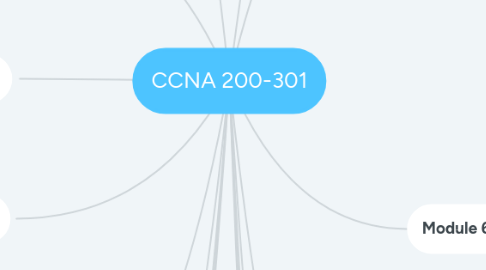
1. Module3: Protocols and Models
1.1. Message Delivery Optiosn
1.1.1. Unicast
1.1.2. Multicast
1.1.3. Broadcast
1.2. TCP/IP
1.2.1. Applicaton
1.2.2. Transport
1.2.3. Internet
1.2.4. Network Access
1.3. OSI
1.3.1. Application
1.3.2. Presentation
1.3.3. Session
1.3.4. Transport
1.3.5. Network
1.3.6. Datalink
1.3.7. Physical
1.4. 2 Ip address
1.4.1. Source IP address
1.4.2. Destinaton IP address
1.5. IP address contains 2 parts
1.5.1. NW portion
1.5.1.1. IPV4
1.5.1.2. Prefix IPV6
1.5.2. Host portion
1.5.2.1. IPV4
1.5.2.2. Interface ID IPV6
2. Module 4: Physical Layer
2.1. Purpose of the Physical Layer
2.2. Physical Layer Charateristics
2.3. Copper Cabling
2.4. UTP Cabling
2.5. Fiber-Optic Cabling
2.6. Wireless Media
3. Module 5: Number Systems
3.1. Binary Number System
3.1.1. Convert Binary to Decimal
3.1.2. Convert Decimal to Binary
4. Module 7: Ethernet Switching
4.1. Ethernet Frames
4.2. Ethernet MAC Address
4.2.1. Unicast MAC address
4.2.2. Broadcast MAC address
4.2.3. Multicast MAC address
5. Module 9: Address Resolution
5.1. MAC and IP
5.1.1. Des on the same network
5.2. Destinaton on remote Network
5.2.1. When the destination IP address is on a remote network, the destination MAC address is that of the default gateway.
5.2.1.1. ARP is used by IPv4 to associate the IPv4 address of a device with the MAC address of the device NIC.
5.2.1.2. ICMPv6 is used by IPv6 to associate the IPv6 address of a device with the MAC address of the device NIC.
5.3. ARP
5.3.1. 2 basic functions
5.3.1.1. Resolving IPv4 addresses to MAC addresses
5.3.1.2. Maintaining an ARP table of IPv4 to MAC address mappings
5.3.2. ARP request
5.3.2.1. If there is no ARP table entry is found, then the device sends an ARP request
6. Module 13: ICMP
6.1. ICMP Messages
6.1.1. ICMPv4
6.1.2. ICMPv6
7. Module 15: Application Layer
8. Module 17: Build a Small Network
9. Module 11: IPv4 Addressing
9.1. Network and Host Portions
9.1.1. 32 bit
9.2. Subnet Mask
9.3. The Prefix Length
9.4. NW,Host,Broadcast address
9.5. VLSM
9.6. Uncicast,Multicast,Broadcast
10. Module 1: Networking today
11. Module 2: Basic Switch and End Device Configuration
11.1. Privileged EXEC mode : enable
11.2. Global Configuration Mode: exit
11.3. Configuration pass: Line console 0
11.3.1. Password abc
11.3.1.1. login
11.3.1.1.1. end
11.4. Securing privileged EXEC mode access
11.4.1. enable secret abc
11.4.1.1. exit
11.5. Configuration Device: Configure Terminal
11.6. Securing VTY line access
11.6.1. line vty 0 15
11.6.1.1. password abc
11.6.1.1.1. login
11.7. Encrypt Passwords
11.7.1. service password-encryption
11.7.1.1. exit
11.8. Banner Messages
11.8.1. User comman: banner motd #abc#
11.9. Save file
11.9.1. copy startup-config running-config
11.10. Configure IP Addressing
12. Module 6: Data Link Layer
12.1. Topoligies
12.1.1. Physical Topology
12.1.2. Logical topology
12.1.3. WAN topologies
12.1.3.1. Point to point
12.1.3.2. Hub and spoke
12.1.3.3. Mesh
12.1.4. LAN topologies
12.1.4.1. Bus
12.1.4.2. Ring
12.1.5. Half and Full Duplex Communication
12.1.6. The Frame
12.1.7. Layer 2 address
12.1.8. LAN and WAN frames
13. Module 8: Network Layer
13.1. Characterstics
13.1.1. The NW layer
13.1.1.1. 4 basic operations
13.1.1.1.1. Addressing end devices
13.1.1.1.2. Encapsulation
13.1.1.1.3. Routing
13.1.1.1.4. De-encapsulation
13.2. Ipv4 packet
13.2.1. binary
13.2.1.1. TTL
13.2.1.1.1. Layer 3 hop count. When it becomes zero the router will discard the packet
13.2.1.2. Src
13.2.1.2.1. 32 bit
13.2.1.3. Des
13.2.1.3.1. 32 bit
13.3. Ipv6 Packets
13.3.1. hexadecimal
13.3.1.1. 128 bit
13.3.1.1.1. Src
13.3.1.1.2. Des
13.4. Host Routes
13.4.1. Default Gateway
14. Module 10: Basic Router Configuration
14.1. Configure Initial Router Settings
14.1.1. decive name
14.1.1.1. hostname abc
14.1.2. secure privileged EXEC mode
14.1.2.1. enable secret abc
14.1.3. secure user EXEC mode
14.1.3.1. line console 0
14.1.3.1.1. password abc
14.1.4. secure remote telnet/SSH accsess
14.1.4.1. line vty 0 4
14.1.4.1.1. password abc
14.1.5. encrypt all plaintext passwords
14.1.5.1. service password encryption
14.1.6. Provide legal notification and save the configuration
14.1.6.1. banner motd #abc#
14.1.6.1.1. end
14.2. Configure Interfaces
14.2.1. interface gig0/0
14.2.1.1. ip address 192.168.0.1 255.255.255.0
14.2.1.1.1. ipv6 address 2001:0db8:85a3:0000:0000:8a2e:0370:7334/64
14.3. Configure the default gateway
15. Module 12: Ipv6 addressing
15.1. 128bits and written in hexadecimal
15.2. Omit leading zero
15.2.1. 012b
15.2.1.1. 12b
15.3. Double colon
15.3.1. 2001:db8:cafe:1:0:0:0:1
15.3.1.1. 2001:db8:cafe:1::1
15.3.1.1.1. use once

